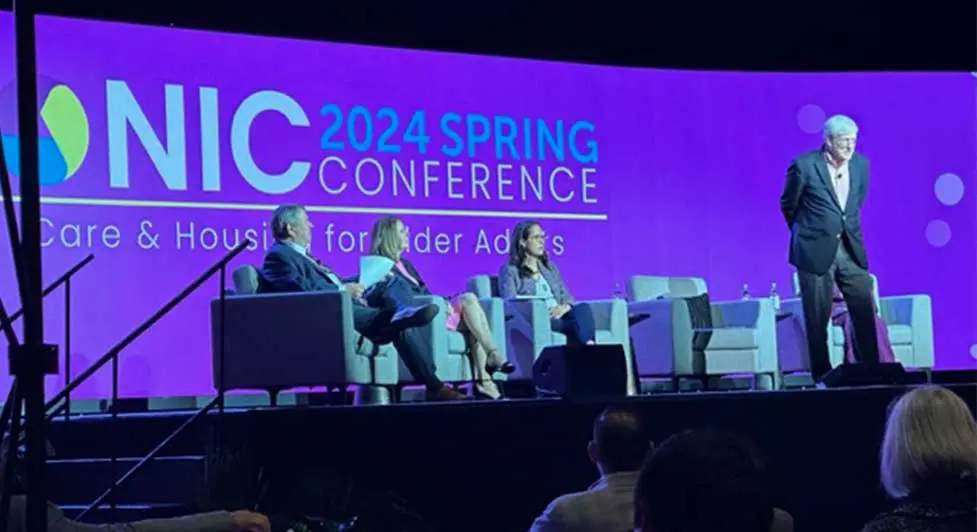Combatting ageism and negative perceptions of seniors housing and care communities has been an ongoing struggle for decades, as positive industry news has difficulty finding its way into the spotlight. Fortunately, for those advocating for the benefits of seniors housing and care, there is new research that finds that older adults in senior living communities live longer, healthier lives than those who do not.
The study was among several key pieces of research unveiled at the 2024 National Investor Conference (NIC) Spring Conference. In an opening session, researchers from NIC MAP, the Milken Institute Future of Aging, and the Joint Center for Housing Studies of Harvard University all presented new data that proves the value of seniors housing and highlights the needs for more affordable housing and care options.
Seniors Housing Residents Live Longer than Peers
A new study, supported by NIC and the NORC at the University of Chicago, examined the two years following a move into seniors housing, a critical time when changes are happening and operators strive to mitigate risks. Researchers looked not only at how long residents lived, but other metrics like how often they used preventative services and how long they were prescribed anti-psychotics.
“Longevity is not only adding years to life, but also adding life to years,” as pointed out by panelist Diane Ty of the Milken Institute.
The study examined seniors housing residents from 2017 to 2019 (pre-COVID) compared with a matched peer group in the greater community. The findings show that seniors housing residents live longer, receive more health care, obtain more preventive and rehabilitation services, and spend less time on anti-psychotics as compared to non-congregant peers on their own.
“Older adults who live in seniors housing live longer than those who do not,” Milken said, pausing for emphasis. The phrase hung in the air for a moment, signaling its importance. One could sense that everyone in the room had long known that phrase to be true and was now excited to have data to substantiate the claim.
It was pointed out, however, that variability among senior living properties is meaningful, as there was wide variation between the top 25% and bottom 25% of communities. As such, there remains work to be done to learn why certain communities consistently rate higher and how those qualities can be replicated.
Dual Burden of Housing and Care
Another notable piece of research promoted during NIC was the Joint Center for Housing Studies of Harvard University’s recent study of 97 U.S. metropolitan areas which found that one-third of older adults (11 million) are housing burdened, meaning more than 30% of their income goes to housing. Compound that with declining rates of home ownership and growing debt levels, and the problem intensifies. Although the study’s findings varied by location (Pennsylvania, Ohio, Michigan, and North Carolina are the furthest from being able to afford housing and care, while California and Utah are closest), it was evident that far too many lack the funds needed for their future and more housing and care alternatives are needed.
Corroborating Harvard’s work, the Milken Institute’s recent report “Innovative Financing and Care Models to Scale Affordable Housing Solutions for Middle-Income Older Adults” explores ways to identify and overcome the most common barriers that prevent the scaling of middle-market solutions. By taking advantage of the current market dislocation and opportunity it provides to repurpose older buildings, whose value are currently being set, and by developing partnerships to pay for care needs for middle-market residents, we can expand options in a meaningful way, according to Milken’s Ty. She discussed four potential solutions to this growing problem:
- Repurpose distressed seniors housing and care communities. There is ample housing stock in need of upgrades, therefore there are opportunities to bring together experienced operators and lenders to refinance, renovate, and transform distressed properties into healthy communities.
- Design sustainable capital for development and acquisition. Developed in response to the limited access to equity, the idea is for a revolving loan fund that offers concessionary money. As initial loans get repaid, that money goes back into the fund for other borrowers. The thinking is that government or philanthropic funding could be the initial funding source to get such a program started.
- Implement pay-for-performance model as a new revenue stream. If communities do their jobs of helping older adults live longer, healthier lives, then insurers are benefitting from fewer claims. How does the rest of the industry share in that revenue?
- Regional pilot to generate data supporting partnerships between seniors housing operators and payers in value-based care. The transition to value-based care models provides an opportunity to integrate data capture that demonstrates the bottom-line impacts of services.
